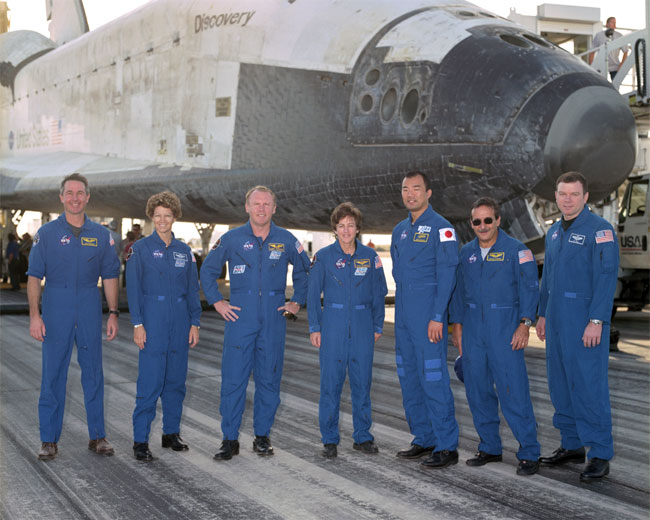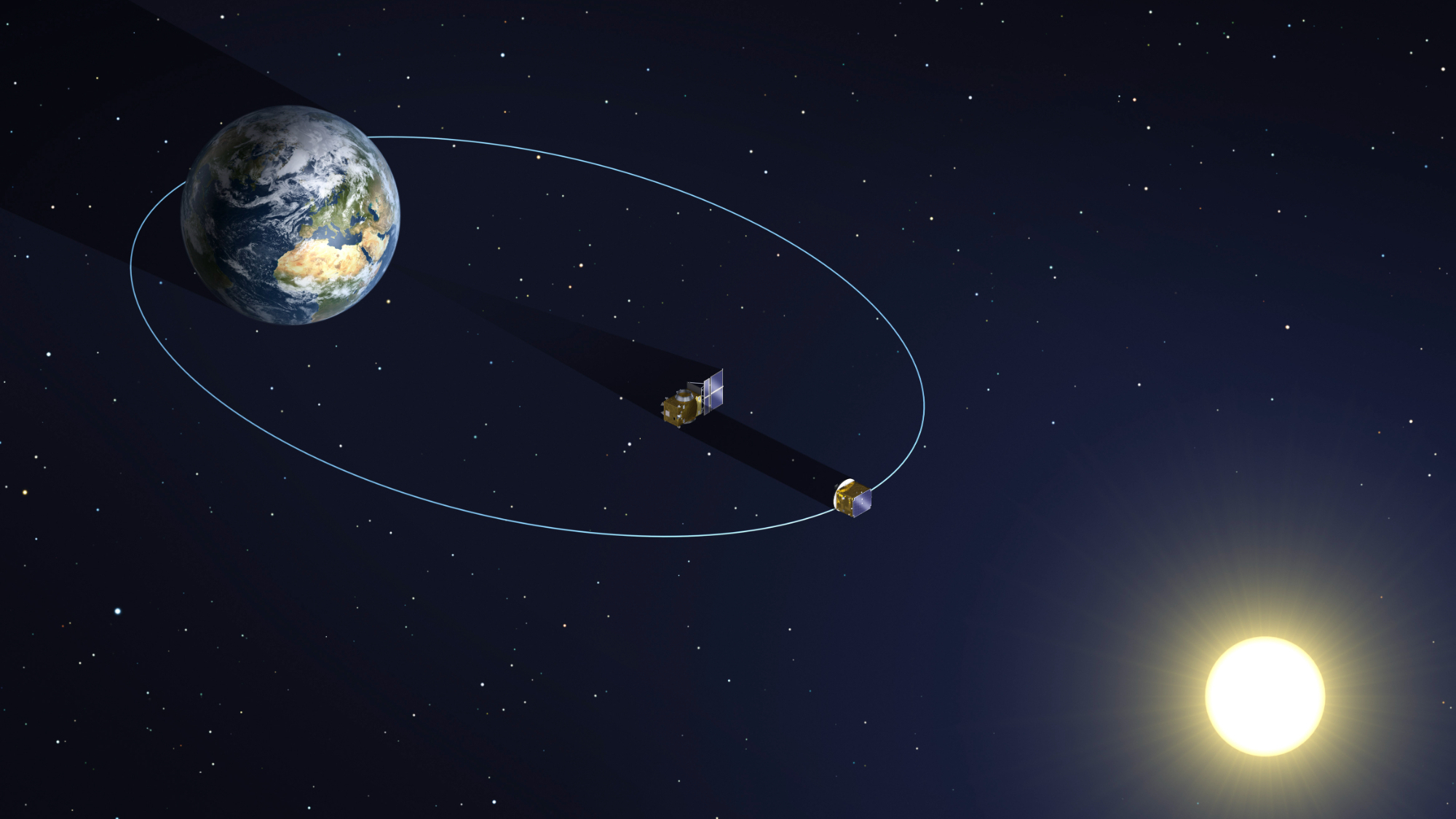STS-114 Astronauts Celebrate Successful Mission, Remember Columbia's Crew

CAPE CANAVERAL, Fla.--Hours after touching down on Earth following a two-week stint in space, the crew of the space shuttle Discovery are still reintroducing themselves to their home planet after completing NASA's first orbiter mission since the Columbia disaster.
"I, personally, am not 100 percent yet," Discovery's STS-114 mission commander Eileen Collins told reporters, citing difficulties in once again acclimating to Earth's gravity. "I think the first think we want to do is see our families."
Collins and her six Discovery crewmates safely landed Tuesday on a concrete runaway at NASA's Dryden Flight Research Center at Edwards Air Force Base. Their spacecraft touched down at 8:11:22 a.m. EDT (1211:22 GMT) after a 14-day mission to the International Space Station (ISS) that marked NASA's first shuttle flight in more than two and a half years.
Collins, shuttle pilot James Kelly, and STS-114 mission specialists Stephen Robinson, Charles Camarda and Soichi Noguchi--of the Japanese Aerospace Exploration Agency (JAXA)--spoke about their two-week space trip during an afternoon briefing.
Mission specialists Andrew Thomas and Wendy Lawrence were still undergoing medical testing, which stretched into the briefing time, but were healthy, Collins said.
"They're in great shape," Collins said of Thomas and Lawrence. "Don't worry about them."
Remembering Columbia
Get the Space.com Newsletter
Breaking space news, the latest updates on rocket launches, skywatching events and more!
Collins, who landed Discovery at Edwards after weather prevented two sets of KSC landing attempts, said she and her crew were excited to be home, but remembered the human price that led to their test flight.
"Today is a very happy day for us," Collins said, "but we have mixed feelings." The loss of Columbia's STS-107 astronauts was paramount in their minds, she added, "so it's a very bittersweet day for us."
The seven STS-107 astronauts died on Feb. 1, 2003 when Columbia broke apart during reentry 16 minutes before landing here at Kennedy Space Center (KSC). The spaceflight was an astounding success, but was cut short when hot atmospheric gases entered a hole in Columbia's left wing gouged by a 1.67-pound chunk of external tank foam weeks earlier at launch.
"Obviously, Columbia was very close in our minds," Noguchi said, adding that his most precious memories will be the joint meals between Discovery and ISS crews.
NASA spent more than two years and $1.4 billion redesigning portions of shuttle external tanks, developing new tools and methods for orbiter inspection and working to enhance shuttle flight safety.
"Odds are, and we accepted the risk and we were willing to fly," Camarda said."
Discovery's flight-tested a new suite of wing leading edge sensors to detect impacts from launch debris and micrometeorites. The STS-114 astronauts also used a sensor-tipped orbiter inspection boom to scan their vehicles for damage.
"I was amazed at how clean the vehicle is," Camarda said. "It is one of the cleanest vehicles we have ever flown."
Even so, a 0.9-pound piece of foam popped free from Discovery's external tank during the orbiter's July 26 launch. That piece did not strike Discovery, but was one of five chunks too large for NASA's new post-Columbia safety standards. In response, shuttle officials announced early on in the STS-114 flight that they would not launch another orbiter until the foam issue is resolved.
"We still need to find out exactly what happened and where the foam came from," Collins said, adding that memories of the Columbia accident and the STS-107 crew were present during the flight.
Tribute and trepidation
Discovery carried a portrait of Columbia's lost crew and the STS-114 astronauts held a tribute to the fallen astronauts and others who have died in the course of space exploration.
"For me, there was a moment of trepidation right before Eileen [Collins] hit the execute on the de-orbit burn," Kelly said.
The shuttle pilot said that as Collins started the burn, he paid special attention to the orbiter's status and watched for signals such as an uncontrolled yaw, or thrusters firing, that appeared during Columbia's ill-fated descent about 16 minutes before landing
"Through that region specifically, I was watching to see if there were any warning signs coming, not that there was anything to do about it," Kelly said. "We had a much better idea on this flight on the shape that we were in, so there was not too much trepidation going through my mind, but certainly a moment of reflection."
Spacewalks and beauty
Noguchi and Robinson staged three spacewalks from Discovery's airlock during their mission, once if which included a first-ever repair of the orbiter's tile-covered heat shield along its belly.
"What it showed is that you can get a spacewalking crewmember under the orbiter," Robinson said. "I felt like I could perform several types of repair."
Collins said the views of Earth from space were spectacular, and at the top of her list of things she'll miss the most about flying in orbit.
"I'm going to miss looking back at the Earth from space," Collins said.
But human spaceflight, and particularly the shuttle, is a great way to explore the human spirit, so long as the risk is acceptable, she added.
"Some people say we should stop flying the shuttle because we've had an accident, frankly we've had two accidents," Collins said, referring to both the Columbia and Challenger disasters. "But...we ask you to please listen to us. Space exploration is just a fantastic part of the human experience."
- Fixing NASA: Complete Coverage of Space Shuttle Return to Flight
Join our Space Forums to keep talking space on the latest missions, night sky and more! And if you have a news tip, correction or comment, let us know at: community@space.com.

Tariq is the Editor-in-Chief of Space.com and joined the team in 2001, first as an intern and staff writer, and later as an editor. He covers human spaceflight, exploration and space science, as well as skywatching and entertainment. He became Space.com's Managing Editor in 2009 and Editor-in-Chief in 2019. Before joining Space.com, Tariq was a staff reporter for The Los Angeles Times covering education and city beats in La Habra, Fullerton and Huntington Beach. In October 2022, Tariq received the Harry Kolcum Award for excellence in space reporting from the National Space Club Florida Committee. He is also an Eagle Scout (yes, he has the Space Exploration merit badge) and went to Space Camp four times as a kid and a fifth time as an adult. He has journalism degrees from the University of Southern California and New York University. You can find Tariq at Space.com and as the co-host to the This Week In Space podcast with space historian Rod Pyle on the TWiT network. To see his latest project, you can follow Tariq on Twitter @tariqjmalik.
